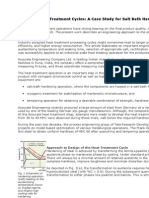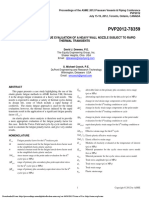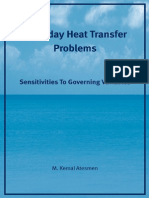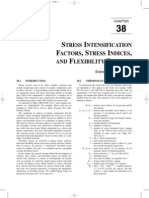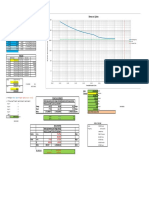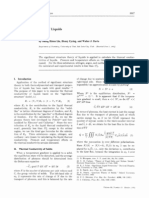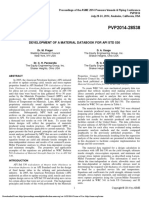Creeplife-Larson Miller Parameter PDF
Creeplife-Larson Miller Parameter PDF
Uploaded by
Isaac Samuel RajaCopyright:
Available Formats
Creeplife-Larson Miller Parameter PDF
Creeplife-Larson Miller Parameter PDF
Uploaded by
Isaac Samuel RajaOriginal Title
Copyright
Available Formats
Share this document
Did you find this document useful?
Is this content inappropriate?
Copyright:
Available Formats
Creeplife-Larson Miller Parameter PDF
Creeplife-Larson Miller Parameter PDF
Uploaded by
Isaac Samuel RajaCopyright:
Available Formats
10.
Creep Life Prediction: Creep tests take a long time to perform making the
generation of design data expensive and the lead time between developing a
new alloy and its exploitation excessive. The fact that there is an Arrhenius
relation between creep rate and temperature has led to a number of time-
temperature parameters to be developed which enable extrapolation and
prediction of creep rates or creep rupture times to longer times than have been
measured. They also enable rating comparisons to be made between different
materials. It is important that no structural changes occur in the region of
extrapolation, but since these would occur at shorter times for higher
temperatures it is safer to predict below the temperature for which data is known
than above. One parameter used is the Larson-Miller Parameter.
•
æQö
This is derived by taking natural logs of the Arrhenius equation: ε = Aexp− ç ÷
è kT ø
(Note that k is being used here instead of R so that Q is quoted in joules per
atom. Also, if logs to the base 10 are used, the Larson-Miller Constant values
given below are multiplied by log10e = 0.43429)
• Q • Q
ln ε = ln A − , ∴ ln A − ln ε = . If we assume that the creep strain to rupture
kT kT
ε r is a constant over the temperature range of interest, and the major part of the
creep strain is steady state creep, then the average creep rate over the life to
• ε
rupture, t r , of the specimen is: ε = r .
tr
æε ö Q
∴ ln A − lnçç r ÷÷ = ln A − ln ε r + ln t r =
è tr ø kT
∴ T (C1 + ln t r ) = = P ...(11), where C1 = ln A − ln t r is the Larson-miller
Q
k
Constant and P is the Larson-Miller Parameter for a particular stress, since
Q = (Q0 − vσ ) . Plotting experimental data of
1
ln t r versus gives a straight line with slope
T
1
P and intercept at = 0 of - C1 . The values
T
of C1 range from 35 to 60, but is typically 46,
and Figure 26 shows that it is independent of
stress.
Figure 26: Stress rupture data plotted as
ln(rupture time) versus reciprocal of absolute
temperature.
Figure 27: Shows a plot of stress
versus Larson-Miller
Parameter for the alloy
Astroloy.
It is clear that for a given stress,
the Larson-miller Parameter for
the material can be obtained and the time to rupture predicted for any
temperature. Alternatively, given a lifetime required at a specified temperature,
the L-M Parameter can be calculated and the maximum allowed stress looked up
on a graph like Figure 26. E.g., For a 100,000 hour life at 870oC (1143 K),
P = 1143(ln105 + 46) = 65.7.103. This corresponds to a stress of 85 MNm-2.
In practice, alloys used in applications like turbine blades experience a wide
range of stresses and temperatures for varying times during start-up, take-off,
steady flight, landing and shut-down. Creep strains accumulate during these
stages and design could assume a 'worst case' scenario, but this would lead to a
weight penalty in the aero-engine and less payload. Alternatively, an approach
similar to Miner's Law in fatigue can be adopted, and this is called the 'Life
fraction rule'. This states that rupture occurs when the sum of all the fractions of
the rupture life at different stress/temperature combinations becomes equal to
unity. I.e.
æt t t ö t 1
å çç t 1 + t 2 + t 3 .....÷÷ = å i t i = ò t dt =1 ....(12), where ti is the time spent at a
è R1 R2 R3 ø Ri R
particular stress/ temperature combination where the time to rupture is t Ri . The
data in Figure 9 can be used to carry out such a calculation.
You might also like
- Material Alloy KHR35CLDocument2 pagesMaterial Alloy KHR35CLIebe Seventynine67% (3)
- Design of Heat Treatment CyclesDocument5 pagesDesign of Heat Treatment CyclesAnonymous s6xbqCpvSWNo ratings yet
- (J. Gilbert Kaufman) Parametric Analyses of High-T (BookFi) PDFDocument170 pages(J. Gilbert Kaufman) Parametric Analyses of High-T (BookFi) PDFLiviu BadeaNo ratings yet
- 1999 OMAE99 PIPE-5037 Bai - Bending Moment Capacity of PipesDocument13 pages1999 OMAE99 PIPE-5037 Bai - Bending Moment Capacity of Pipesdmlsfmm100% (1)
- Sec.6 - Class C Heat ExchangerDocument33 pagesSec.6 - Class C Heat ExchangerAgung Dewandaru MahatmantoNo ratings yet
- A Method of Creep Rupture Data Extrapolation Based On Physical ProcessesDocument10 pagesA Method of Creep Rupture Data Extrapolation Based On Physical ProcessesAndrea CalderaNo ratings yet
- Hoop Stress and Wall Thickness in Storage TanksDocument7 pagesHoop Stress and Wall Thickness in Storage Tanksandi suntoroNo ratings yet
- Analysis of Transient Thermal Stresses in A Delayed Coke Drum - PDFXDocument8 pagesAnalysis of Transient Thermal Stresses in A Delayed Coke Drum - PDFXShivangi ThakkerNo ratings yet
- PREn - Pitting Resistance Equivalent NumberDocument2 pagesPREn - Pitting Resistance Equivalent NumberJacinto Gomez Emboletti0% (1)
- WRC-510-2006 240812 134320Document63 pagesWRC-510-2006 240812 134320Kirubhakar.pNo ratings yet
- Clemex: ASTM E1268 Banding AnalysisDocument1 pageClemex: ASTM E1268 Banding Analysissmallik3No ratings yet
- Imp-Pvp2012-78359-Elastic-Plastic Fatigue Evaluation of A Heavy Wall Nozzle Subject To Rapid Thermal TransientsDocument10 pagesImp-Pvp2012-78359-Elastic-Plastic Fatigue Evaluation of A Heavy Wall Nozzle Subject To Rapid Thermal Transientsbomika100% (1)
- API Creep RuptureDocument3 pagesAPI Creep RuptureRavi Raj100% (1)
- 304 304h Data SheetDocument4 pages304 304h Data SheetHuỳnh Thanh TrườngNo ratings yet
- Diaphragm Elimination Using Taper-Lok - NPRADocument11 pagesDiaphragm Elimination Using Taper-Lok - NPRAN. S. PanditNo ratings yet
- Sodium Leak Through Pin HolesDocument9 pagesSodium Leak Through Pin HolesAvinash ChittellaNo ratings yet
- ASCE 7-05 Table 15-4-2Document1 pageASCE 7-05 Table 15-4-2barouniamineNo ratings yet
- Asme Viii Div.2Document16 pagesAsme Viii Div.2rps1977100% (1)
- Strain Hardening Austenitic SteelDocument8 pagesStrain Hardening Austenitic SteelAndré BuysNo ratings yet
- Datasheet DMV 347 HFGDocument4 pagesDatasheet DMV 347 HFGClaudia MmsNo ratings yet
- Heat Transfer Problem 2014Document240 pagesHeat Transfer Problem 2014arminNo ratings yet
- 012 2F PaperDocument10 pages012 2F PaperJean-Noël LerouxNo ratings yet
- 5.1 Pages From Pages From ASME - PCC-2-2008 - Stored Energy CalDocument1 page5.1 Pages From Pages From ASME - PCC-2-2008 - Stored Energy CalRafeeq Ur RahmanNo ratings yet
- At N.p.c.i.l., RawatbhataDocument30 pagesAt N.p.c.i.l., RawatbhataDevendra SharmaNo ratings yet
- Verification of Lifting Lug (As Per OVS For MPD, P-III) : y All VDocument4 pagesVerification of Lifting Lug (As Per OVS For MPD, P-III) : y All VGohar ZamanNo ratings yet
- QU AL ITY: Material Data SheetDocument5 pagesQU AL ITY: Material Data SheetAlex007No ratings yet
- DesignGuidelinesfortheSelectionandUseofStainlessSteels 9014Document7 pagesDesignGuidelinesfortheSelectionandUseofStainlessSteels 9014gusiNo ratings yet
- Pipíng & Stress Analysis Ref - Sofware Caesar II. 06-09-2017 Autor - Ing R L Morard - U T N 1Document9 pagesPipíng & Stress Analysis Ref - Sofware Caesar II. 06-09-2017 Autor - Ing R L Morard - U T N 1Oswaldo GuerraNo ratings yet
- P17-1TS-KBR Bolting Types Carbon & Alloy SteelDocument2 pagesP17-1TS-KBR Bolting Types Carbon & Alloy Steelyulianus_sr100% (1)
- ASME Ch38 p001-018 11-8-08Document18 pagesASME Ch38 p001-018 11-8-08Dan MorganNo ratings yet
- Chap 03Document42 pagesChap 03Americo MolinaNo ratings yet
- 60 Steam Turbine ManagementDocument25 pages60 Steam Turbine ManagementLTE002100% (2)
- Plane Strain Fracture Toughness Data Handbook For MetalsDocument92 pagesPlane Strain Fracture Toughness Data Handbook For Metalsmp87_ing100% (2)
- Asme b18.2.1 Hvy Hex BDocument1 pageAsme b18.2.1 Hvy Hex BPhú PhạmNo ratings yet
- WRC-541 Part2Document75 pagesWRC-541 Part2vvpvarunNo ratings yet
- Annex 3-F Design Fatigue Curves (Smooth Bar)Document1 pageAnnex 3-F Design Fatigue Curves (Smooth Bar)ข้าวเม่า ทอดNo ratings yet
- USS PlateDocument78 pagesUSS Platepipedown456No ratings yet
- 39 Ni CR Mo 3Document2 pages39 Ni CR Mo 3Lokesh Krishnappa100% (2)
- VECTOR TECHLOK CLAMP CONNECTOR TECHNICAL BROCHURE - PDFDocument9 pagesVECTOR TECHLOK CLAMP CONNECTOR TECHNICAL BROCHURE - PDFmariusmihaibNo ratings yet
- API 510 Hydrostatic Head PressureDocument40 pagesAPI 510 Hydrostatic Head PressureHarmish mewadaNo ratings yet
- Carbon Steel Piping Comp. StandardsDocument2 pagesCarbon Steel Piping Comp. StandardsSoumitra GuptaNo ratings yet
- KubotaDocument12 pagesKubotaFebri Ramdani NugrahaNo ratings yet
- Curso ASMEDocument123 pagesCurso ASMEEduardo DepiattiNo ratings yet
- FFS 3Document2 pagesFFS 3phutiNo ratings yet
- Manurite 900bDocument2 pagesManurite 900bAhtsham AhmadNo ratings yet
- Mechanical Model of Scraper Rake Torque in Deep-cone Thickener - 《Journal of Central South University (Science and Technology) 》2012年04期Document1 pageMechanical Model of Scraper Rake Torque in Deep-cone Thickener - 《Journal of Central South University (Science and Technology) 》2012年04期saidNo ratings yet
- Astm C133Document6 pagesAstm C133Teddy HariyantoNo ratings yet
- Designing of Pressure Vessel FinalDocument18 pagesDesigning of Pressure Vessel FinalTeuku Muhammad ArrahmanNo ratings yet
- Sa 320Document13 pagesSa 320gst ajahNo ratings yet
- A213A213M-15b Standard Specification For Seamless Ferritic and Austenitic Alloy-Steel Boiler, Superheater, and Heat-Exchanger TubesDocument14 pagesA213A213M-15b Standard Specification For Seamless Ferritic and Austenitic Alloy-Steel Boiler, Superheater, and Heat-Exchanger TubesChuthaNo ratings yet
- RAL & BS Color CardDocument5 pagesRAL & BS Color Cardponnivalavans_994423No ratings yet
- SA253MA DetailDocument16 pagesSA253MA Detailksquare2001100% (1)
- Ug-32 Formed Heads, and Sections, Pressure On Concave Side (A)Document1 pageUg-32 Formed Heads, and Sections, Pressure On Concave Side (A)Shukri NasirNo ratings yet
- Coke Drum Skirt ExampleDocument10 pagesCoke Drum Skirt Example2009tamerNo ratings yet
- Analysis Elevated Temperature Creep SteelDocument66 pagesAnalysis Elevated Temperature Creep SteelematlisNo ratings yet
- Workshop: Mixing Tee: ANSYS Fluent Getting StartedDocument39 pagesWorkshop: Mixing Tee: ANSYS Fluent Getting StartedSahil Jawa100% (1)
- Probabilistic Physics of Failure Approach to Reliability: Modeling, Accelerated Testing, Prognosis and Reliability AssessmentFrom EverandProbabilistic Physics of Failure Approach to Reliability: Modeling, Accelerated Testing, Prognosis and Reliability AssessmentNo ratings yet
- Cplife PDFDocument2 pagesCplife PDFGirish RaoNo ratings yet
- Tube Banks Single-Phase Heat Transfer inDocument22 pagesTube Banks Single-Phase Heat Transfer inarif aktaşNo ratings yet
- Conductivity of Solids 12-2009Document14 pagesConductivity of Solids 12-2009sakshi130193No ratings yet
- Thermal Of: Condilnctivity LiquidsDocument4 pagesThermal Of: Condilnctivity LiquidsER Gaurav BathlaNo ratings yet
- Creeplife-Larson Miller Parameter PDFDocument2 pagesCreeplife-Larson Miller Parameter PDFIsaac Samuel RajaNo ratings yet
- Development of A Material Databook For Api STD 530Document10 pagesDevelopment of A Material Databook For Api STD 530Zenon Kociuba100% (1)
- A Comprehensive Approach To Reformer Tube InspectionDocument13 pagesA Comprehensive Approach To Reformer Tube InspectionHéctor S. RodríguezNo ratings yet
- Safe Remaining Lifetime Assesment of Power Plant Steam BoilersDocument9 pagesSafe Remaining Lifetime Assesment of Power Plant Steam Boilersmuh4iminNo ratings yet
- Theory and Application of Time Temperature ParametersDocument19 pagesTheory and Application of Time Temperature ParametersAnonymous KzJcjGCJbNo ratings yet

